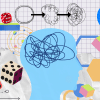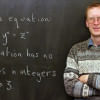The Dimensions of Infinity

I
People first started to count in singles and duals. They didn't assign numbers. I, you, he, she would refer to one. Duals were expressed with an "operator": He and you; neither this nor that; either you or I.
Then came the challenge to describe three or more. For that, people relied on we, us, they, many.
Counting became a necessity when cities emerged. For practical purposes, around here, large units were lac or lakh (105); crore or koti (107). There are units in the Indian Vedic number system that express one lakh crore as one sanku (1012); a maha sanku as one lakh sanku (1017); even one vikrant (1067) and one maha vikrant (1072). The international number system has vigintillion (1063) and centillion (10103).
These large numbers would have been enough, had it not been for Archimedes.
Archimedes asked: Is there an upper bound to the number of grains that can fit into the universe? He had to redefine counting, and so introduced the "beast number". The Archimedes Beast Number is 1 followed by 80 quadrillion zeros.
Is there a number larger than that? Yes. It's called infinity. And to describe infinity, we need to redefine the way we count.
II
You cannot count to infinity. In space, you can fit more and more people into a room, and still there would be some space leftover to accommodate more people. In time, the clock will carry on adding a second and will never stop. This means there's no upper bound or limit to infinity. We need to think differently.
Our first exposure to infinity comes in school when learning ratios. If y < x, then x / y > 1. As y becomes smaller and smaller compared to x, the ratio becomes larger and larger. How large can the ratio become? If negatives are ruled out, then the smallest value for y will be zero. We all know x / 0 = ∞. Since ∞ can't be counted, some texts define this special relationship as undefined.
If something is undefined, then something is unknown. This opens a wide box of defining infinity that may not be as large as we might think.
III
At the ground floor, you're waiting for the elevator to come down. An indicator tells you where the lift is. You patiently wait; the end is defined.
Flip this situation. You're at the same place, blindfolded. You don't know when the lift will come, although you know the building is finite. The end is undefined. When something is undefined, it will be uncertain.
Here's a little teaser.
A mathematician requests a friend to meet him any time after 5 by sending a text, x > 5.
The mathematician then starts to read Alice in Wonderland. When Alice asked the White Rabbit, "How long is forever?", he responded, "Sometimes, just one second."
The mathematician hears the bell ring. It's a minute past five. His friend, smiling, asks, "Didn't you say x > 5?"
The poor mathematician. What could have lasted for long, ended abruptly.
IV
One of the beauties of math is that it can redefine itself when needed. If counting fails, keep things open-ended. If that doesn't work, is it possible to show infinity visually, through graphs on a 90-degree gradient?
These are questions mathematicians ask. The beast of the discipline is that schools almost never expose students to the intuitive beauty of math when they're young.
Asrar Chowdhury teaches Economics in classrooms. Outside, he watches Test cricket, plays the flute and listens to music and radio podcasts. Email: [email protected] or [email protected]

 For all latest news, follow The Daily Star's Google News channel.
For all latest news, follow The Daily Star's Google News channel. 







Comments